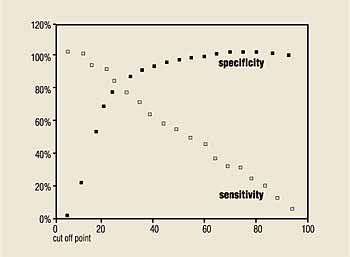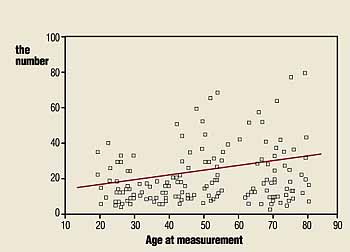Limits of neural network parameter change with age
“The Number” currently is the most important parameter available in the GDx, a clinician says.
LONDON — The GDx parameter called The Number increases with age, so allowing for this increase may yield a higher specificity in older subjects.
Thomas P. Colen, MD, of the Rotterdam Eye Hospital in the Netherlands, concluded that The Number is the single most important parameter to distinguish between normal and glaucomatous eyes.
The GDx (Laser Diagnostic Technologies, San Diego, U.S.A.) is a scanning laser polarimeter that measures nerve fiber layer thickness using a polarized laser beam, Dr. Colen said. The GDx printout gives several parameters, all derived from thickness information belonging to different parts of the retina. Some parameters are direct thickness parameters; ratio parameters and modulation parameters also are calculated. (All parameters, whether direct, ratios or modulation, are calculated from direct measurements.) All parameters are compared to a built-in normative database. From more than 200 parameters, one summary parameter is derived — The Number. The number ranges from 0 to 100. The more parameters are outside normal limits, the higher The Number will be, and the more likely that a patient has glaucoma, he said.
However, diagnosing glaucoma is more than just parameters, so knowing that the parameter changes according to the age of the patient will allow physicians to be more accurate in their diagnoses. Dr. Colen presented his research at the European Glaucoma Society meeting.
Neural network
 ---Sensitivity and specificity
"Promisingly high"
---Sensitivity and specificity
"Promisingly high"
According to Laser Diagnostic Technologies, a custom-designed, two-layered neural network was trained to look at 215 parameters collected during a GDx scan. Parameters evaluated include, but are not limited to, those that appear on the printout and analysis screen of the GDx.
The network was trained by inputting data from equal numbers of glaucoma and normal patients. Normal patients were assigned a value of 0, and glaucoma patients were assigned a value of 1. The determination of “normal” or “glaucoma” was based on clinical examination by ophthalmologists. The degree of glaucoma in the glaucoma patients was primarily early to moderate, with an average mean deviation of –6 dB.
The neural network was tested when two-thirds of the available data was fed into the network. At that point, the remaining third, which had not yet been used to train the network, was evaluated. The result was that the GDx’s neural network identified the glaucoma patients with 94% sensitivity and 97% specificity. Once tested, the remaining data were used to further train the network.
On the GDx printout, the neural network assigns a number between 0 and 100 to each patient. A rank of 0 indicates the patient is totally normal, and 100 indicates glaucoma. Early evaluation of the number indicates that patients who score between 0 and 30 are normal; patients scoring over 70 are glaucomatous; and those scoring between 30 and 70 are glaucoma suspects.
Patients in this last category may prove to be “borderline” or “outside normal limits” on some GDx parameters but may not exhibit any visual field loss or other indications of glaucoma, according to the company.
Most important parameter
Dr. Colen and Hans G. Lemij, MD, PhD, investigated the distribution of The Number in a population of healthy eyes to evaluate the suggested cut-off points of 30 (borderline normal) and 70 (borderline glaucoma) in a group of glaucoma patients.
“The Number currently is the most important parameter available in the GDx,” Dr. Colen told Ocular Surgery News. “We wanted to know the distribution of The Number in a large group of normals and then investigate how well The Number discriminates between normals and glaucoma patients, in contrast with the sensitivity and specificity of a trained physician who is allowed to interpret all data on the GDx printout.”
Increases with age
 ---"The Number" — a neural
networkparamater
---"The Number" — a neural
networkparamater
Researchers enrolled 203 healthy volunteers and 104 glaucoma patients and one randomly selected eye imaged with the GDx. Healthy eyes had an intraocular pressure less than 23 mm Hg, normal visual fields on the Humphrey Field Analyzer with the 24-2 program and normal appearing optic discs. Glaucomatous eyes had reproducible glaucomatous visual field defects (mean deviation of –10.5 dB) and glaucomatous appearing optic discs.
The Number was plotted against age and was increased in the normal subjects with a slope of 0.20 per year. Sensitivity and specificity were calculated for all cut-off points between 5 and 95 in 5-point increments. Sensitivity was 81% and specificity was 88% at a cut-off point of 30. At a cut-off point of 70, specificity was 34%, and sensitivity was 99%.
“Thirty is a good cut-off point for The Number in our study group,” Dr. Colen said. “Most important, we show that, currently, the sensitivity and specificity of The Number alone are promisingly high, 81% and 88%, respectively.”
Furthermore, sensitivity and specificity can increase further if a trained clinician evaluates all data on the GDx printout, he added. The sensitivity and specificity increase to high 80s and low 90s, respectively.
Researchers concluded The Number increases with age, so allowing for this increase may yield a higher specificity in older subjects.
“We need to develop new parameters that somehow copy the complex way in which a trained physician evaluates all available GDx data,” Dr. Colen said. “Some new parameters have already been designed and are currently being tested.”
For Your Information:
- Thomas P. Colen, MD, can be reached at the Rotterdam Eye Hospital, P.O. Box 70030, 3000 LM Rotterdam, The Netherlands; +(31) 10-401-7743; fax: +(31) 10-401-7655. Dr. Colen does not have a direct financial interest in any company mentioned in this article, nor is he a paid consultant for any company mentioned in this article.
- Laser Diagnostic Technologies, Inc., is located at 10864 Thornmint Road, San Diego, CA 92127 U.S.A., +(1) 858-673-7900; fax: +(1) 858-673-7909.
